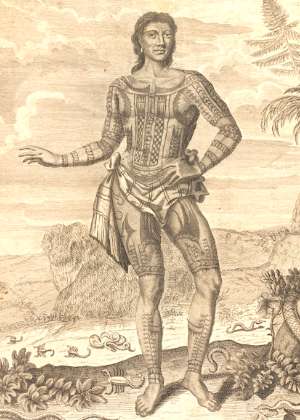
William Dampier brings back to England a tattooed man
After the Church banned the tattoo in 787AD – there was not much in evidence regarding tattooing in Britain in the forthcoming years, and we had to wait until 1691, when the tales of William Dampier became reality.
Historically Dampier was the first Englishman to set foot in Australia – but it is said that he was not a great explorer and did not find anything that the Dutch had not found before him, although he was somewhat of a colourful character and a noted buccaneer and great navigator.
And it was on one of his journeys to the South Seas where Dampier came across Scottish Explorer Alexander Selkirk. Who was marooned on an uninhibited Island? This event was to later prompt Daniel Defoe’s famous book “Robinson Crusoe”.
William Dampier was born in East Coker, Somerset, England and at an early age he wanted to see the world. So at 18 he became a ships apprentice and did just that. Traveling the world 3 times and after many adventures Dampier returned to England on the 16th of September 1691 bringing with him the tattooed Prince Giolo (aka Jeoly), who soon became an instant attraction and crowds would come from miles around to see him, as Giolo was marked from head to toe.
But on Dampier’s return to England, things didn’t pan out as he had planned and through lack of money he handed Giolo over to a group of eminent businessmen who pressured William into giving up ‘The Painted Prince’ (as he became known) and it was they (not Dampier) who benefited and put Giolo onto the exhibition scene with one of his first engagements being at the place of his lodgings at ‘The Blew-Boars-Head’ public alehouse in Fleet Street, London.
Flyers were also printed and given out describing the ‘Painted Prince’ as being a wonder of the age, his whole body is curiously and most exquisitely painted or stained, full of variety and invention with prodigious skill performed.
This of course just being a small part of the advertising flyers statement as in England during this period there was a huge appetite with the public for the freak show, where even the ‘Royal Society’ had a museum of human rarities. There was also competition from the many executions that went on throughout London at the time as well as the theatre putting on plays and the like. Giolo’s new owners even had a book printed up, which came via a Dutchman who supposedly knew Giolo’s language and had taken down the story from the Prince’s own mouth, of which Dampier had dismissed as being untrue.
Indeed Dampier was far from happy, and in his own first book, he wrote that it was a ‘want of money’ that forced him to hand over his prized prince, and even went in as far as saying that he had been cheated out of him and that he had fallen amongst rooks (crooks). But alas all the bitterness didn’t last long as Giolo became ill and died of smallpox a few months later in Oxford, England in 1692.
As for William Dampier he signed his last will and testament on the 29th of November 1714. And there is a memorial to him at St Michael’s Church of East Coker. Records also show that he was christened there on September the 5th 1651, but his date of birth is not known, nor his date of death or to where he is buried.
Copyright…Paul Sayce.
Posted on 15th April 2009



